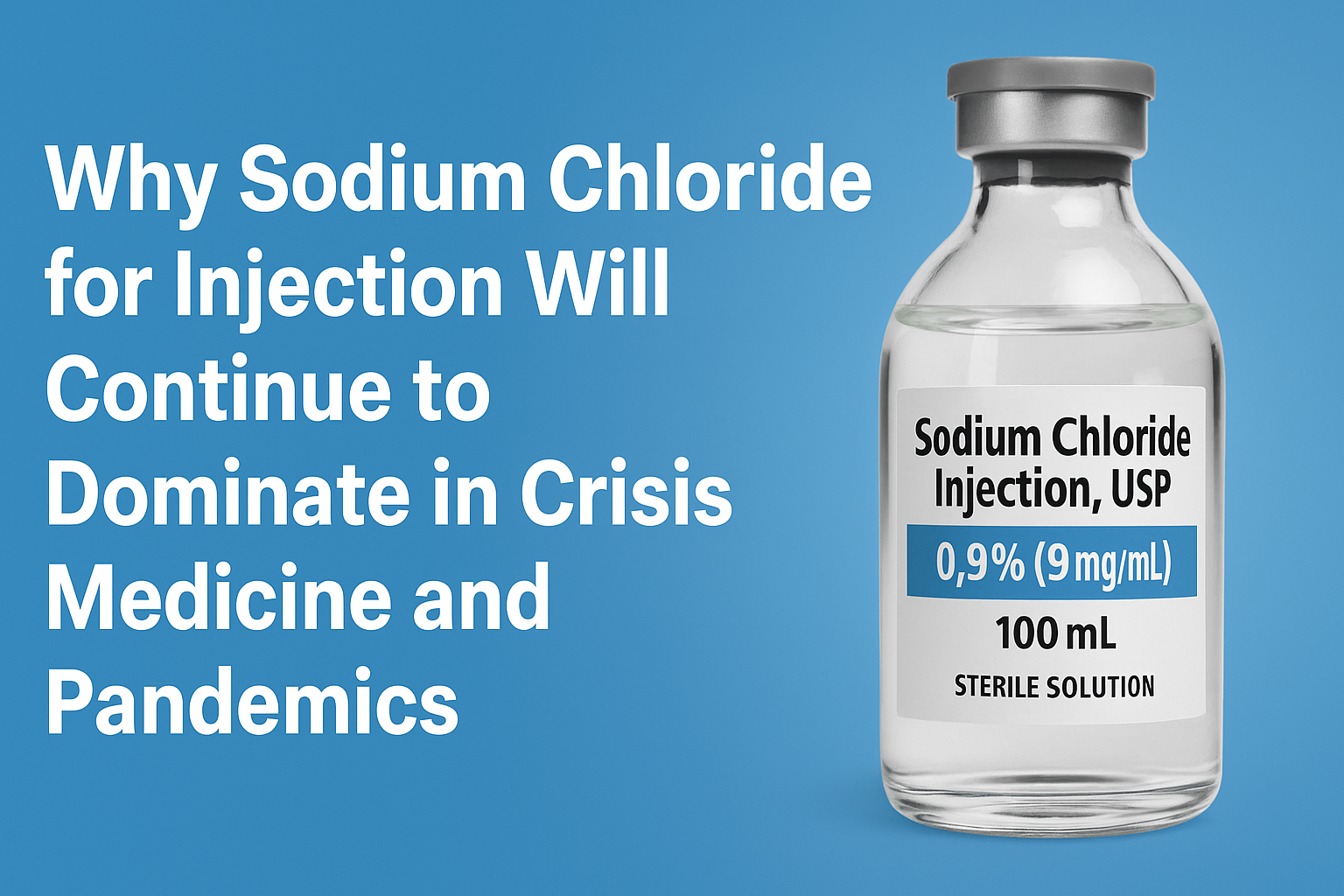Why Sodium Chloride for Injection Will Continue to Dominate in Crisis Medicine and Pandemics

Strong 8k brings an ultra-HD IPTV experience to your living room and your pocket.
As global health systems confront emerging threats—from COVID‑19 variants to natural disasters and conflict zones—Sodium Chloride for Injection (normal saline, 0.9 %) remains a cornerstone of critical care, emergency response, and vaccine logistics. This blog explores why this humble IV solution will continue to lead in crisis medicine, grounded in research, pragmatic use cases, and future resilience planning.
1. A Proven Lifeline in Fluid Resuscitation
Normal saline (0.9 % NaCl) is WHO‑listed as an essential medicine and remains the default IV fluid in hypovolemia and shock due to its isotonicity and accessibility.
In sepsis and septic shock management, recent studies still rely on saline for its immediate volume‑restoring effect. In one large secondary analysis of the CLOVERS trial, patients receiving lactated Ringer’s had slightly lower 90‑day mortality (12.2 %) compared with 0.9% saline (15.9 %)—adjusted hazard ratio 0.71 (95 % CI, 0.51–0.99). Though balanced crystalloids may offer incremental benefit, saline remains preferred in rapid pre‑hospital and austere scenarios.
Furthermore, trials such as SMART, SALT‑ED, and BaSICS generally found no statistically significant mortality reduction compared to saline within the first 24 hours of resuscitation emphasizing that saline still performs reliably in early crisis care.
2. In Vaccine Preparation & Pandemic Logistics
Sodium chloride is not just for resuscitation—it’s also a key excipient in COVID‑19 vaccines, including Pfizer‑BioNTech (BNT162b2), AstraZeneca (ChAdOx1), Sputnik V, and Janssen (Ad26.COV2.S). As a buffer maintaining pH stability and osmolarity, NaCl ensures vaccine integrity during storage, reconstitution, and administration.
Supply chains for vaccine programs in remote settings frequently include saline ampoules for dilution and delivery—making consistent, pharmaceutical‑grade saline a logistical linchpin in global immunization and emergency response.
3. Anti‑Inflammatory & Immune‑Modulating Effects in COVID‑19
While isotonic saline is standard, hypertonic NaCl solutions (e.g. 3 % NaCl) have sparked interest as adjunctive therapy in severe COVID‑19.
A narrative review highlights that hypertonic saline may:
- Regulate leukocyte function and neutrophil extracellular traps (NETosis),
- Reduce endothelial and tissue edema,
- Restore NaCl homeostasis disrupted in COVID‑19,
- And control cytokine storms in severe lung disease.
In vitro, concentrations of 1.2 % NaCl inhibited SARS‑CoV‑2 replication by 90%, with total inhibition at 1.5 % in primate kidney cell lines.
These findings offer a mechanistic rationale for hypertonic saline use, though large-scale clinical trials are still needed.
4. Symptomatic Relief via Saline Irrigation
Beyond IV use, nasal and oral saline irrigation (isotonic or mildly hypertonic) has shown benefit in early COVID‑19 infection.
A Frontiers narrative review found that saline irrigation:
Reduced nasopharyngeal viral load,
Hastened viral clearance,
Relieved symptoms and potentially lowered hospitalization risk,
Without harm, as a complement to masks and hygiene.
Early saline rinsing—twice or more daily—could be a low‑cost adjunct to reduce transmission and progression in pandemic settings.
5. Critical in Emergency Preparedness & Field Hospitals
In disaster zones or field hospitals, infrastructure is minimal, and speed is essential. Sodium Chloride for Injection is:
Lightweight, sterile, and easy to store,
Versatile across hydration, electrolyte correction, and medication dilution,
Universally accepted and familiar to providers.
Its shelf stability and low-temperature sensitivity make it ideal for unpredictable supply chains—from refugee camps to mobile clinics.
As future pandemics and crises proliferate, planners emphasize stockpiling pharmaceutical-grade NaCl injection in national reserves and humanitarian caches.
6. Long-Term Safety Profile & Recognized Risks
Bacteriostatic Saline’s benefits are balanced by known physiological limitations. Rapid infusion of large volumes may cause hyperchloremic metabolic acidosis, contributing to potential AKI and electrolyte disturbance.
While hyperchloremia correlates with AKI in septic patients, large RCTs like SMART and SALT‑ED have not demonstrated significantly worse outcomes versus balanced fluids in the early phase. Thus, while alternatives may offer marginal long-term benefit, saline remains justifiable in acute, high‑pressure contexts.
7. Key Insights & Quotable Findings
“Hypertonic NaCl solutions have marked effects on neutrophil function and NETs formation, emerging as a promising adjuvant therapy in COVID‑19.”
“Isotonic saline irrigation… was found to reduce nasopharyngeal viral load, hasten viral clearance, and relieve symptoms of COVID‑19.”
From sepsis studies: “Initial fluid resuscitation with lactated Ringer’s… might be associated with improved survival… compared with 0.9% saline.” (although saline remains preferred when balanced fluids are unavailable).
8. Visual Ideas: Infographics & Trends
To illustrate the enduring dominance of NaCl injection:
Timeline infographic showing steady global usage of 0.9 % saline in hospital protocols since mid‑20th century.
Bar-chart comparing volume percentages of saline vs balanced crystalloids used in early acute care (e.g. pre‑hospital, first 24 h).
Flow diagram of a field hospital kit featuring saline bottles, illustrating multi-purpose versatility.
Mechanism sketch of hypertonic saline acting on neutrophils and mucosal surfaces to curb inflammation and viral load.
These visuals reinforce your text and make complex data accessible.
9. Looking Ahead: Why NaCl Injection Will Retain Its Edge
Global supply availability: Salt is abundant and cost‑effective, enabling mass production.
Interchangeable compatibility: Works with most medications and vaccines; universal applicability.
Familiarity & training: Health workers worldwide are trained to use saline, lessening error risk in emergencies.
Multiple modalities: Usable in IV therapy, irrigation, nebulization, dilution, and reconstitution.
Resilience to disruptions: Stable in varied environmental conditions—key during logistical breakdowns.
While new fluids or carriers emerge, none match saline’s ubiquity and proven infrastructure support.
✅ Conclusion
In an era when rapid response determines outcomes, Sodium Chloride for Injection (0.9 % saline) remains unmatched in crisis medicine and pandemic logistics. Backed by decades of clinical use, essential medicine listing, and emerging immunomodulatory research, saline will continue to be a linchpin in treating dehydration, shock, respiratory inflammation, and vaccine administration.
As health planners and frontline responders prepare for future crises, ensuring access to pharmaceutical‑grade NaCl injection is non‑negotiable.
Looking for pharmaceutical‑grade Sodium Chloride Injection in Australia?
Click here to order safely and ensure your facility is stocked and ready.
Note: IndiBlogHub features both user-submitted and editorial content. We do not verify third-party contributions. Read our Disclaimer and Privacy Policyfor details.


